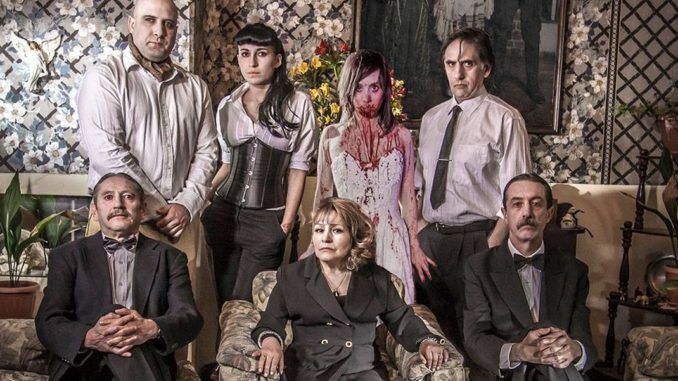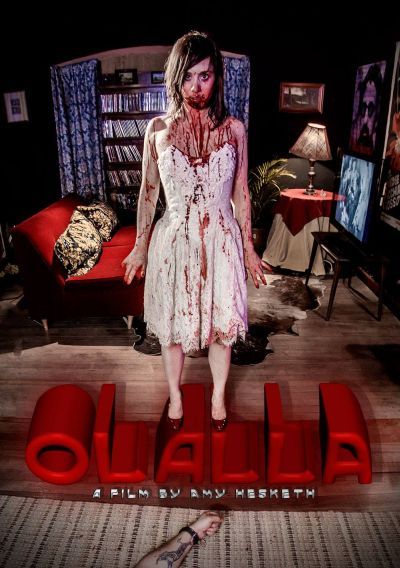
Rating: C
Dir: Amy Hesketh
Star: Amy Hesketh, Mila Joya, Jac Avila, Luis Almanza
It’s a long way from Scotland to Bolivia. But that’s the journey this story took. It’s based (to a degree) on a tale by Scottish author Robert Louis Stevenson, best known for writing the ‘Strange Case of Dr Jekyll and Mr Hyde’. His short story ‘Olalla’ dates from around the same time, and is about a wounded soldier in Spain sent to recuperate with a weird local family. Once of noble blood, they are now descending into decay, perhaps due to inbreeding. While he falls for the daughter, Olalla, she eventually attacks him in a way some have interpreted as vampiric. Though others read it simply as animalistic, without any supernatural components, a result of the family’s decline into degeneracy.
Then there’s this movie. Let’s see what the keywords are, the IMDb has to offer: “crucified-woman, tied-to-a-bed, spreadeagled, tied-to-a-post, burned-alive…” aaaand that’s enough Internet Movie Database for today, I think. Let’s just say, few of those elements are to be found in the original story. Though if you can look past them, you can see how this has elements in common with the synopsis of the previous paragraph. Hesketh, who wrote, directed, starred in, and co-produced this, leans solidly towards the vampire interpretation, in her story of a bizarre clan. It unfolds both in the modern era, and a parallel thread, taking place in the 1880s. Most of the family appear in both, present as somewhat – albeit not a century-plus – younger versions in the earlier thread.
 Hesketh seems an intriguing character. She went to Bolivia initially to act in a National Geographic documentary about typhus. There she saw a film by Avila, stayed in the country, and made a series of movies with him – most of which seem to have strong themes of sadomasochism (and as we’ll see, this does). Her most recent feature is a version of Pygmalion, starring Avila as Higgins and Joya as Eliza Doolittle. We’ve previously mentioned the elements of male dominance in that tale which are potentially problematic to some modern viewers. Does sound interesting, especially if it leans into those elements rather than rejecting them, like Emma Thompson’s mercifully aborted My Fair Lady remake was going to do.
Hesketh seems an intriguing character. She went to Bolivia initially to act in a National Geographic documentary about typhus. There she saw a film by Avila, stayed in the country, and made a series of movies with him – most of which seem to have strong themes of sadomasochism (and as we’ll see, this does). Her most recent feature is a version of Pygmalion, starring Avila as Higgins and Joya as Eliza Doolittle. We’ve previously mentioned the elements of male dominance in that tale which are potentially problematic to some modern viewers. Does sound interesting, especially if it leans into those elements rather than rejecting them, like Emma Thompson’s mercifully aborted My Fair Lady remake was going to do.
Certainly, she puts it all out there in her performance. By which I mean, with Mathilda May in Lifeforce levels of nudity, and the IMDb keywords are a pretty good summary of what her characters endure during the movie. But I suspect the fact the film has a female director, and she is also the actress in question, largely defuse any potential suggestion of exploitation. If this were a Jess Franco movie, probably starring Lina Romay, then I suspect the conversation around it might be rather different. A double standard? Probably. But it’s a bit like the way you can’t complain about Jackie Chan the director putting Jackie Chan the actor in peril to make Police Story. You have to give artists the leeway to make their art.
It’s a different take on vampires, to be sure. The ones here have no issues with daylight or any of the other traditional lore. They just drink blood, with the state being passed on genetically, rather than through the act. This seems to have led to the family becoming rather incestuous, or at least certainly tolerating it. They’re also very keen on keeping below the radar, which is why Olalla (Hesketh) gets in trouble after ripping her boyfriend’s throat out during an ill-advised screening of Nosferatu. To ensure she is brought back in line, the family turns to Uncle Felipe (Avila), whose approach consists of tying Olalla up, beating her with a riding crop and raping her. He’s also in a more consensual BDSM relationship with her sister, Ofelia (Joya).
That’s the contemporary strand. There’s also the 1880’s story, in which Hesketh plays a different character called Olalla, the mother of her two daughters. This story-line does more closely reflect the original story, with a convalescent sent to live with the family. It doesn’t end well. By which I mean a mob with torches drags this Olalla into the village square, strips her, ties her to a crucifix, where she is whipped (below) and eventually set on fire. This torment goes on forever. Seriously. Initially shocking, it felt like I ran the whole gamut of reactions thereafter, from finding black humour in its relentlessness, to getting kinda bored, before eventually circling back to finding it disturbing. All told though, I was left feeling this should have been a separate movie, the parts never successfully gelling.
 I think the modern part works better, offering a better range of bizarre characters in the family to sustain attention. For example, there are two other uncles living in the house, who look and dress similarly, moving in sync. We never see them anywhere, except sitting on the sofa. It feels like something out of The League of Gentlemen. Or there is the earnest discussion on the topic of muffins. Conversely, things unfold in a mix of English and Spanish, and this leads to too much acting in a second language, on both sides, not helped by intermittently muffled audio. It’s clear, for example, Hesketh is not a native Spanish speaker, and though Olalla’s weird accent [accompanied by derisive snorts from Chris, who is a native speaker] is brought up, no credible answer is ever provided.
I think the modern part works better, offering a better range of bizarre characters in the family to sustain attention. For example, there are two other uncles living in the house, who look and dress similarly, moving in sync. We never see them anywhere, except sitting on the sofa. It feels like something out of The League of Gentlemen. Or there is the earnest discussion on the topic of muffins. Conversely, things unfold in a mix of English and Spanish, and this leads to too much acting in a second language, on both sides, not helped by intermittently muffled audio. It’s clear, for example, Hesketh is not a native Spanish speaker, and though Olalla’s weird accent [accompanied by derisive snorts from Chris, who is a native speaker] is brought up, no credible answer is ever provided.
It doesn’t utterly derail proceedings, since awkwardness is part of Olalla’s character. There’s not much dramatic drive either, except for the arrival of a guest (Almanza), whom I suspect is intended to end up in the crystal decanters from which the family drink. As in the Stevenson story, he falls for Olalla, but another ill-advised viewing of Nosferatu, combined with Ofelia’s jealousy, means it also ends as well as you would probably expect, i.e. “not very”. This is a film with some interesting ideas, but in the end it feels like the movie keeps getting in the way of itself, though I undeniably respect Hesketh’s commitment to her art.
This review is part of our October 2024 feature, 31 More Countries of Horror.
